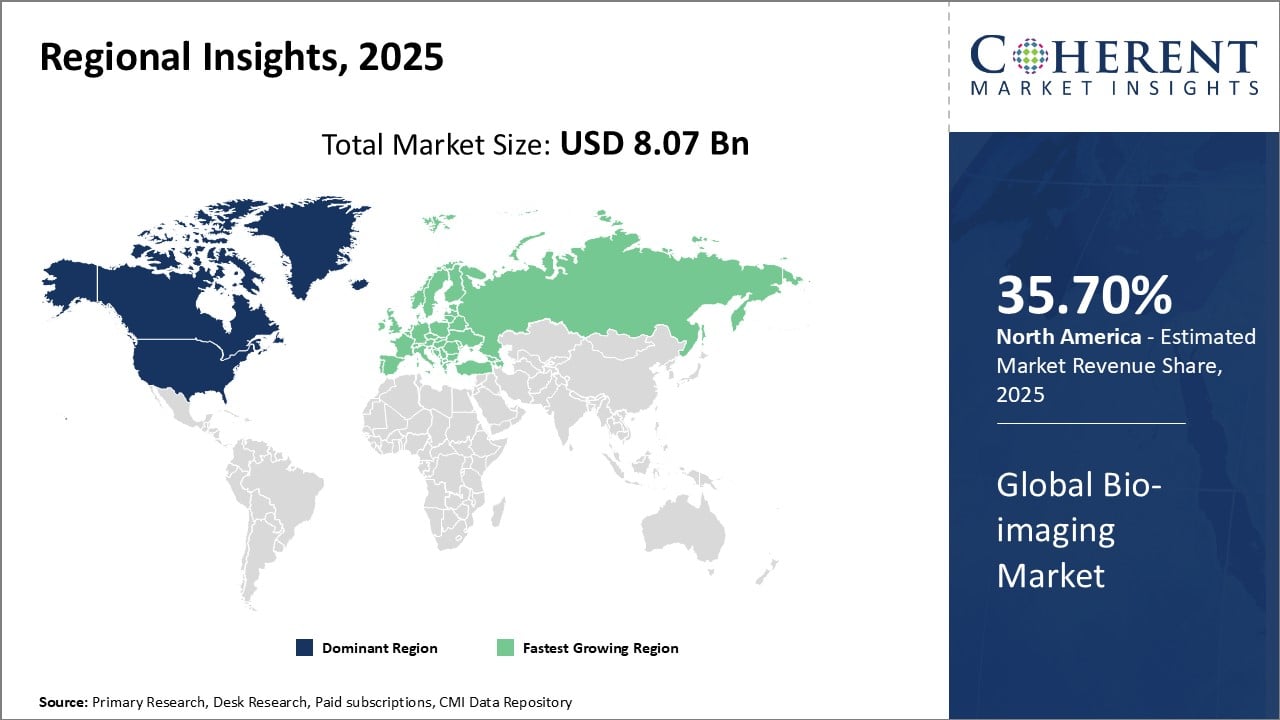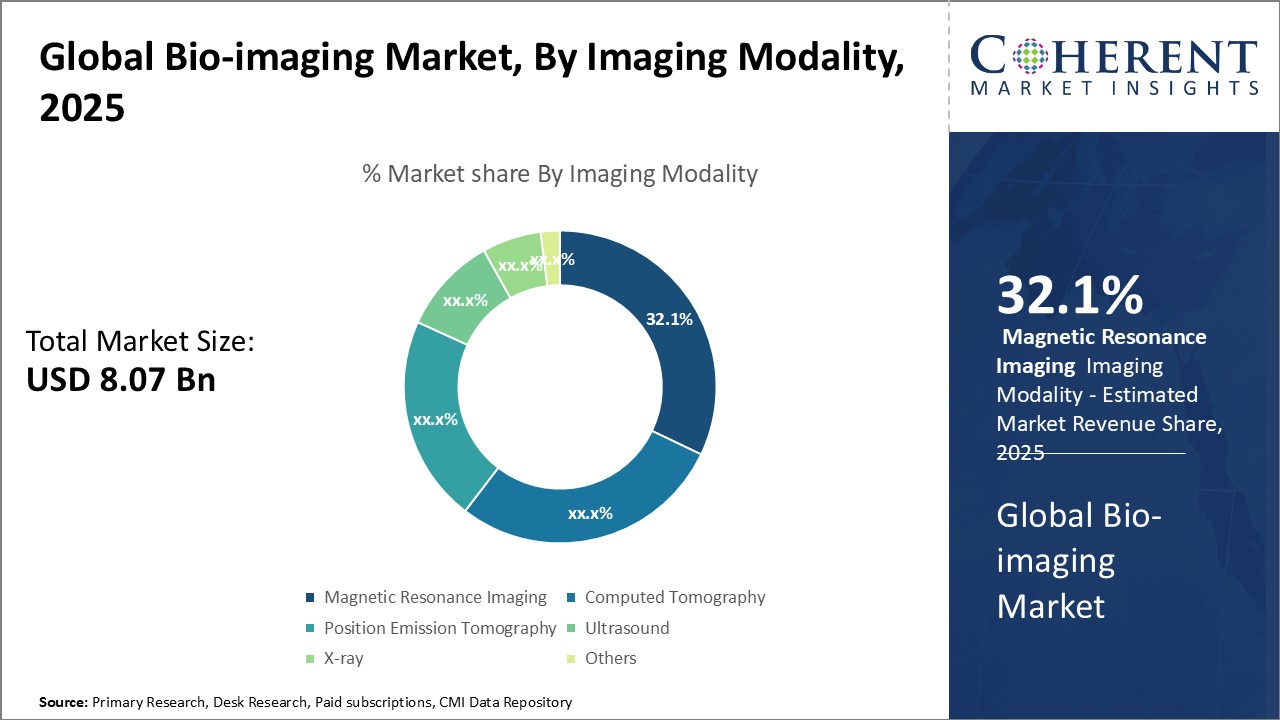Global bio-imaging market size is expected to reach US$ 22.13 Bn by 2032, from US$ 8.07 Bn in 2025, exhibiting a compound annual growth rate (CAGR) of 15.5% during the forecast period.
Bio-imaging refers to visualization of biological processes taking place inside living systems at both molecular and macroscopic levels through the use of imaging technologies. Global bio-imaging market has been witnessing steady growth over the forecast period. Factors such as rising geriatric population and advancement in biosciences such as genomics and proteomics are driving demand for imaging modalities to understand complex biological processes.
Global Bio-imaging Market- Regional Insights
- North America is expected to be the largest market for bio-imaging during the forecast period, accounting for over 35.7% of the market share in 2025. The North America bio-imaging market is driven by several factors such as increasing demand for non-invasive diagnostic techniques, rising prevalence of chronic and lifestyle diseases, and others.
- Asia Pacific market is expected to be the second-largest market for bio-imaging market, accounting for over 25.2% of the market share in 2025. Technology advancement is a key driver propelling the Asia Pacific bio-imaging market. Manufacturers are continually working on developing innovative imaging systems with improved resolution, speed, and diagnostic capabilities. Artificial intelligence (AI) integration with imaging devices is also gaining traction.
- Europe market is expected to be the fastest-growing market for bio-imaging market, with a share of 19.0% during the forecast period. Europe bio-imaging market is driven by the opportunities due to ongoing research on nanoparticle-based bio-imaging, growing applications of AI and 3D bio-imaging, expansion in therapeutic applications, and untapped potential in certain European countries.
Figure 1. Global Bio-imaging Market Share (%), By Region, 2025

To learn more about this report, Download Free Sample
Analyst View: Global bio-imaging market is growing at a fast pace driven by rising geriatric population and increasing prevalence of chronic diseases. Rapid developments and technological advancements in imaging modalities such as magnetic resonance imaging (MRI), ultrasound, computed tomography (CT) and positron emission tomography (PET) are enabling early disease diagnosis. The need for frequent patient monitoring has also boosted demand. While increasing applications of bio-imaging methods present growth opportunities, budgetary constraints faced by healthcare providers may act as a restraint.
Global Bio-imaging Market- Drivers
- Technological advancements in bio-imaging modalities: Technological advancements in bio-imaging modalities are strongly driving the growth of global bio-imaging market. The new generation bio-imaging techniques are allowing researchers to gain deeper insights into biological processes at the cellular and molecular level. Advanced modalities like optogenetics, two-photon microscopy and super resolution microscopy are enabling researchers to visualize cellular structures and interactions like never before. These high-resolution live cell imaging techniques are revolutionizing the fields of neuroscience and developmental biology by providing incredibly detailed real-time views of complex biological systems.
- Growing prevalence of chronic and infectious diseases: Growing burden of chronic and infectious diseases across the globe is a major factor driving the growth of the global bio-imaging market. With rising life expectancy and changing lifestyle trends, non-communicable diseases like cancer, cardiovascular diseases, and neurological disorders are on the rise. For instance, according to the American Cancer Society’s report, in January 2022, there will be an estimated 1.9 Bn new cancer cases diagnosed and 609,360 cancer deaths in the U.S.
- Growing applications of bio-imaging in drug discovery, clinical trials and regenerative medicine research: Bio-imaging is playing a pivotal role in various fields of medical research and drug development. With advancements in high-resolution imaging techniques such as MRI, PET, CT and multi-photon microscopy, researchers are able to gain deeper insights into biological processes at the molecule, cell and whole organ levels. This is driving significant growth in the bio-imaging market. Technology providers are increasingly offering advanced bio-imaging solutions integrated with data analysis and artificial intelligence capabilities. This is enabling researchers to longitudinal track disease progression and drug response non-invasively over time at high spatiotemporal resolution.
Global Bio-imaging Market- Opportunities
- Companion diagnostics and personalized medicine: Companion diagnostics along with personalized medicine offers a great opportunity to drive growth in the global bio-imaging market. With advancements in precision medicine and targeted drug therapies, the need for biomarkers and companion diagnostics is increasing significantly. Bio imaging techniques play a vital role in disease diagnosis, treatment selection, and monitoring drug response at an individual level. These personalized healthcare approaches require robust bio-imaging tools that can accurately detect molecular and cellular abnormalities.
- Hybrid imaging systems: Hybrid imaging systems have the potential to be a major opportunity in the global bio-imaging market. Hybrid imaging combines two or more imaging modalities together, harnessing the strengths of each individual technique while compensating for their limitations. This integrated approach allows researchers and medical professionals to gain complimentary anatomical and functional insights from a single examination. Hybrid imaging is gaining traction as it provides more comprehensive visualization and characterization of biological systems. Combining modalities such as PET/CT, SPECT/MRI and ultrasound with CT or MRI gives clinicians and scientists enhanced functionality.
Global Bio-imaging Market Report Coverage
| Report Coverage | Details | ||
|---|---|---|---|
| Base Year: | 2024 | Market Size in 2025: | USD 8.07 Bn |
| Historical Data for: | 2020 To 2024 | Forecast Period: | 2025 To 2032 |
| Forecast Period 2025 to 2032 CAGR: | 15.5% | 2032 Value Projection: | USD 22.13 Bn |
| Geographies covered: |
|
||
| Segments covered: |
|
||
| Companies covered: |
Bracco Imaging S.P.A, Bayer HealthCare Pharmaceuticals, Esaote S.p.A, Digirad Corporation, FONAR Corporation, GE Healthcare, Hologic Inc., Hitachi Medical Corporation, Lantheus Medical Imaging, Inc., Covidien Pharmaceuticals, Mindray Medical International Limited., Gamma Medica Inc., Samsung Medison Co., Ltd., and Philips Healthcare. |
||
| Growth Drivers: |
|
||
| Restraints & Challenges: |
|
||
Uncover macros and micros vetted on 75+ parameters: Get instant access to report
Global Bio-imaging Market- Trends
- Adoption of artificial intelligence (AI) and robotics in bio-imaging systems: Integration of artificial intelligence and robotics in bio-imaging systems is having a significant impact on the global bio-imaging market. The use of AI and machine learning algorithms is allowing bio-imaging systems to automate tasks like image classification, detection of abnormalities, segmentation of images, and predictive diagnosis. For instance, in October 2022, TeraRecon, an industry leader in advanced visualization and artificial intelligence (AI) for medical imaging, launch its next-generation Eureka clinical AI platform. The platform serves as an end-to-end clinical application integrating multiple AI algorithms and workflows.
- Development of advanced biochemical and probes: The development of advanced biochemical and probes is significantly influencing the global bio-imaging market. As the research in life sciences deepens, the need for sophisticated tools to visualize biological processes at the molecular, cellular and whole body levels has increased tremendously. Bio-imaging techniques allow researchers to gain novel insights into the functioning of living systems which is crucial for developing diagnostics and therapeutics targeted at various diseases.
Global Bio-imaging Market - Restraints
- High capital investment requirements: One of the key factors that are restraining the growth of the global bio-imaging market is the high capital investment requirements for various imaging modalities and infrastructure development. Establishing a state-of-the-art molecular or functional imaging facility involves significant investments in advanced medical imaging equipment like PET/CT, MRI, ultrasound, and others. These high-end systems come with a steep price tag of millions of dollars. Moreover, to get the most out of these systems, regular software and hardware upgrades are needed which leads to additional recurring costs. The expensive nature of bio-imaging technologies poses a major barrier for research institutions and hospitals especially in developing regions to adopt advanced imaging technologies at a large scale.
- Shortage of skilled professionals: The shortage of skilled professionals is significantly hampering the growth of the global bio-imaging market. As bio-imaging techniques continue to advance at a rapid pace with innovations like artificial intelligence integration and nanotechnology, there is a growing need for trained medical imaging technicians, radiologists, and other specialized healthcare professionals who can efficiently operate sophisticated imaging equipment and accurately analyze the scans. However, most countries are facing an acute deficit of such skilled human resources.
Counterbalance: The key market players needs to provide proper training programs to develop skilled and efficient healthcare personnel to operate sophisticated and complicated imaging equipments.
Figure 2. Global Bio-imaging Market Share (%), By Imaging Modality, 2025

To learn more about this report, Download Free Sample
Global Bio-imaging Market- Recent Developments
Product and Technology Launch
- On October 2, 2023, Exo, a medical imaging startup, launched its newest medical imaging device, Exo Iris, which is a portable ultrasound device that combines point-of-care imaging, artificial intelligence, and health information technology (IT) systems.
- On May 5, 2023, Revvity, Inc., a biotechnology company, enhanced imaging portfolio designed to drive innovation across diverse applications in preclinical research with the launch of three systems. These new innovations include the next-generation IVIS Spectrum 2 and the IVIS SpectrumCT 2 imaging systems, further elevating versatility and sensitivity standards in in vivo optical imaging. QuantumTM GX3 microCT structural imaging solution was also launched with increased resolution and speed for both in vivo and ex vivo imaging, designed to facilitate researchers studying disease biology or evaluating and fast-tracking therapeutic candidates. And making its global debut is the Vega ultrasound system.
Business Development Activities by the Market Players
- On January 5, 2024, Biocare Medical, a leader in fully open automated instrumentation, announced collaboration with Molecular Instruments (MI), the inventor of the hybridization chain reaction (HCR) imaging technology. This partnership brings together Biocare Medical's expertise in automated bio imaging systems with MI's suite of advanced HCR Products, by setting a new standard in automated in situ hybridization (ISH) and immunohistochemistry (IHC).
- On January 5, 2023, Bruker Corporation, a global manufacturer of high-end analytical instruments, announced the acquisition of ACQUIFER Imaging GmbH, a pioneer in big-data management solutions for bioimaging and high-content microscopy. This acquisition adds high-performance on-premise processing, secure storage and networking technology that complements Bruker Corporation’s advanced fluorescence microscopy imaging products, such as light-sheet and super-resolution microscopy products, which generate high information content.
- In January 2021, Olympus Corporation, manufacturer of optics and reprography products, entered into an agreement to acquire Quest Photonic Devices B.V. for up to US$60.7 million (€50 million) including milestone payments to strengthen its surgical endoscopy capabilities. This will incorporate Quest Photonic Devices B.V's advanced Fidelity National Information Services (FIS) capabilities into Olympus Corporation’s comprehensive medical imaging portfolio.
Top Companies in Global Bio-imaging Market
- Bracco Imaging S.P.A
- Bayer HealthCare Pharmaceuticals
- Esaote S.p.A
- Digirad Corporation
- FONAR Corporation
- GE Healthcare
- Hologic Inc
- Hitachi Medical Corporation
- Lantheus Medical Imaging, Inc.
- Covidien Pharmaceuticals
- Mindray Medical International Limited.
- Gamma Medica Inc.
- Samsung Medison Co., Ltd.
- Philips Healthcare
Definition: Bio-imaging refers to the techniques and processes that allow for the visual representation of biological materials within cells, tissues, organs, or entire organisms, often in a non-destructive manner. It encompasses a variety of methodologies that can capture the structure and function of biological entities at various scales – from the visualization of subcellular organelles and molecular processes to the imaging of whole anatomical structures and physiological functions.
Share
Share
About Author
Manisha Vibhute is a consultant with over 5 years of experience in market research and consulting. With a strong understanding of market dynamics, Manisha assists clients in developing effective market access strategies. She helps medical device companies navigate pricing, reimbursement, and regulatory pathways to ensure successful product launches.
Missing comfort of reading report in your local language? Find your preferred language :
Transform your Strategy with Exclusive Trending Reports :
Frequently Asked Questions
Select a License Type
EXISTING CLIENTELE
Joining thousands of companies around the world committed to making the Excellent Business Solutions.
View All Our Clients




